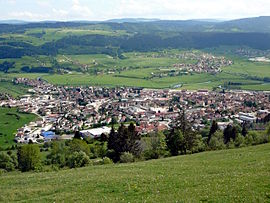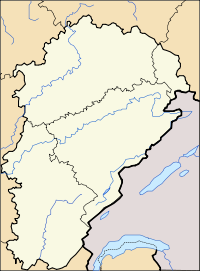- Morteau
-
Morteau
Morteau from Mont Vouillot Administration Country France Region Franche-Comté Department Doubs Arrondissement Pontarlier Canton Morteau Intercommunality Val de Morteau Mayor Annie Genevard
(2008–2014)Statistics Elevation 750–1,114 m (2,460–3,655 ft)
(avg. 800 m/2,600 ft)Land area1 14.11 km2 (5.45 sq mi) Population2 6,499 (2008) - Density 461 /km2 (1,190 /sq mi) INSEE/Postal code 25411/ 25500 1 French Land Register data, which excludes lakes, ponds, glaciers > 1 km² (0.386 sq mi or 247 acres) and river estuaries. 2 Population without double counting: residents of multiple communes (e.g., students and military personnel) only counted once. Coordinates: 47°03′32″N 6°36′25″E / 47.05888°N 6.60694°E
Morteau is a commune, in the Doubs department in the Franche-Comté region in eastern France.
Contents
Geography
This little city is situated in a widening of the Doubs river valley.
The proximity of Switzerland (10 km from Neuchâtel) gives jobs to transborder workers, as well as providing a clientele for the businesses of the Morteau valley.
History
The Roman expansion (200 BCE, 100 CE) began the decline of the Celts. At the Battle of Alesia, at the side of Arvernes, there were an equal number of Mandubiens, the people of Doubs. They were the best riders of Vercingetorix.
Early Middle Ages
At the end of the Roman Empire, the Alamanni invaded the region, followed by the Burgundians.
The region was influenced by the Normans, the Hungarian descendants of the Huns, the Sarrasins. These Arabs stopped by Charles Martel in 732, had followed the valley of the river Saône. Locally, their name was given to the tiny village of Sarrazins above Montlebon.
Middle Ages
In 1105 the name of Morteau appeared for the first time officially. The name of Franche-Comté, however, did not appear until 1366.
A half dozen Benedictine monks of the Cluny order arrived at this time to clear the mountains. They stayed with a resident of the Mondey area and quickly hired workers. They brought in whole families into five districts, each now cities in their own right: Morteau, Villers-le-Lac, Montlebon and Grand'Combe-Châteleu.
Morteau had a feudal castle built on the eastern side of Mondey, it overlooked the ancient celtic road which linked Besançon to Switzerland. The plague killed two thirds of the valley's inhabitants in 1349. The population was rebuilt by immigrants from the canton of Fribourg and the Aoste valley.
Fires
Over eight centuries, seventeen major fires occurred in Morteau, the worst in 1639, 1683, 1702, 1849 and 1865.
Economy
For many centuries, livestock have formed a mainstay of the economy. It is impossible to give a precise origin to the well known montbéliarde breed since all of the livestock in central Europe have similar characteristics and transborder exchanges were always common. One can see white cattle with red stops in certain provinces of the Czech and Slovak republics similar to those from Franche-Comté. The traditional smoked sausages, Morteau Sausage for example, as well as the drinks (syrups and lemonades Rième) and candies (chocolates and caramels Klaus) have made the city renoun. Smoked "Saucisse de Morteau" has to meet a long list of demanding criteria, such as the origin of the meat, how the animals have been fed with, the type of wood that has been used to smoke the sausages,the specific model of chimney. It also has to be produced in Franche-Comté only. It has recently obtained even more juridical protection in order to maintain the high quality of the product on a long term basis. Every August, a two-day celebration takes place into town, in order to determine the "Sausage Gold Award", and it has been ranked among the top three stupidest and most pointless village fete of the country, by a famous weekly French magazine.
Watchmaking was for many years the principal industry of the region. In 1680, a young smith from Sagne repaired an imported English watch and decided to copy it.
Population
Historical population of Morteau 1962 1968 1975 1982 1990 1999 2008 5395 6158 6690 6445 6458 6375 6499 Sights
- Morteau has two very nice chateaus: the Château Pertusier and the current city hall.
- The Château Pertusier was built in 1576 by the Cuche family. During the Swedish attack in 1639, the tower at the top of the winding staircase caught fire and the western side was shot at. One can still see the bullet scars of the biscayens Swedes. The Bole family was then the owner. During the French Revolution, a lawyer from Besançon, Jean-Charles Pertusier bought the building, which had become national property, for a sum of 900 987 pounds. The house and its grounds were bought by the commune in 1935. This building is now one of the few examples of Renaissance Architecture in the Haut-Doubs.
- The city hall was built in 1590 by the Fauche family. Occupied by the officers of Saxe-Weimar, it did not suffer during the war and passed into the hands of the Benedictines, then into those of the Roussel brothers. The commune of Morteau acquired the property in 1793. It now holds some of the municipal offices as well as the famous Black Book, kept safe in the mayor's office. In 1454, a city notary wrote in this book the records of the entire priory. It contains 54 charters from 1188 to 1514, letters of charter, sentences, arrests and conventions. Brought to Switzerland during the Swedish invasion, it was recovered intact after the war.
Notable
- The train station in the city is the site of various scenes from the film Monsieur Batignole starring Gérard Jugnot and Damien Jouillerot (who is from the region);
- It is the site of several scenes from the film L'Adversaire with Daniel Auteuil;
- Laurence Semonin, known as "Madeleine Proust", is from Arces, a hamlet of Morteau;
- The mathematician Jean-Claude Bouquet (1819–1885) was from Morteau.
International relations
Morteau is twinned with:
Local Groups
See also
References
External links
- Morteau on the intercommunal Web site of the department (French)
- City Website
- Videos from the region
- Morteau on the french national geographical institute website
- Morteau on the INSEE website
- Morteau on the QUID website
- Morteau on a map
Categories:- Communes of Doubs
Wikimedia Foundation. 2010.



